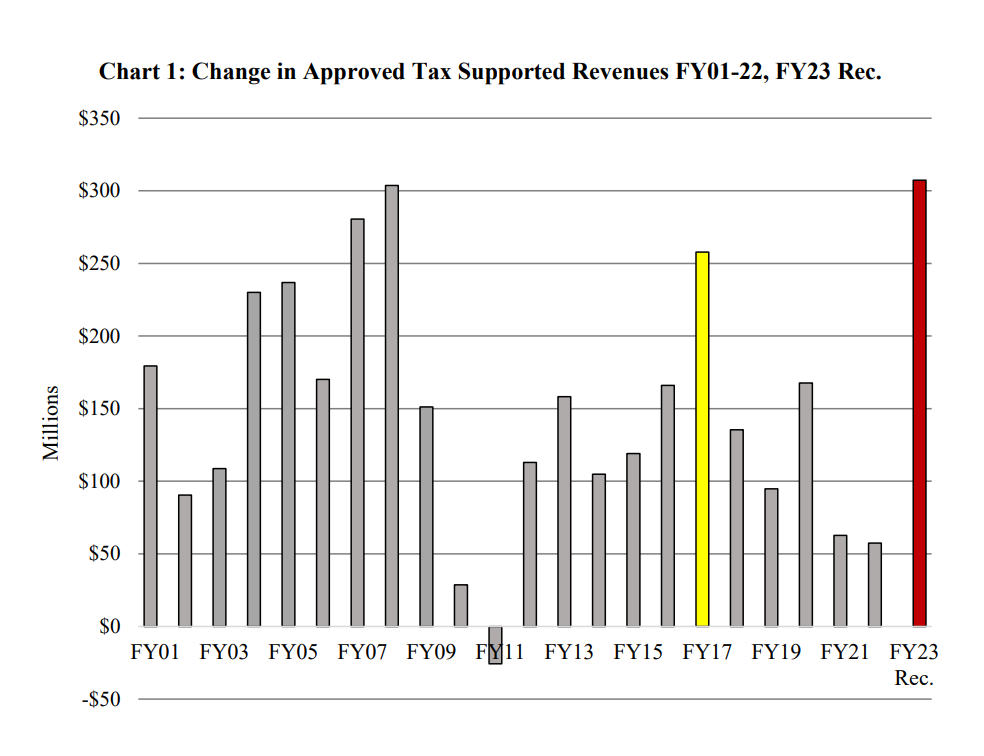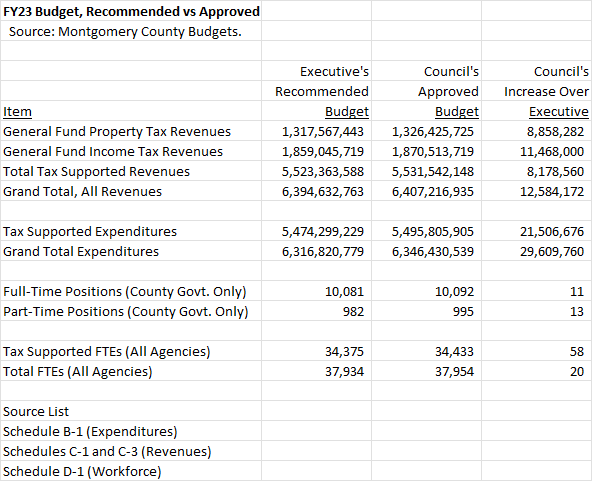By Adam Pagnucco.
The road to this year’s massive tax hike proposal is a long one, paved with years of unsustainable spending. That’s not on the six brand new county council members, who are now going into their first budget season. But as for the others, they knew what was coming. Why do I say that?
Because they were told by the council’s own staff.
On April 19, 2022, the council’s staff released one of the most remarkable budget memos I have seen in my time around county government. Back then, I was working for David Blair’s campaign for county executive. If I were writing, I would have written a series about just this one memo. Like the oracles of ancient Greece, the staff issued a series of ominous prophecies about the county’s budgetary condition. And just like in old myths, the council ignored those prophecies, setting off a chain of dire consequences.
The memo pertained to the county executive’s recommended FY23 budget, which was then under consideration by the council. The staff did not mince words. Right on page one, the warnings began. Here is an excerpt.
*****
The Council’s budget process has been consumed by the pandemic for the last two years – which led to a same services budget in FY21 and modest increases in the FY22 budget largely attributable to one-time Federal resources.
The County Executive’s recommended FY23 Operating Budget communicates a very different narrative compared to the past two years. The Executive’s budget includes unprecedented growth in both projected revenues and recommended expenditures in FY23.
The level of budget growth proposed by the Executive has not been seen since the Great Recession and funds substantial programmatic and/or staffing enhancements across all County agencies.
Council staff has significant concerns about the sustainability of the unprecedented level of spending, use of one-time resources, and multi-year funding commitments included in the recommended budget:
The Executive’s assumed budget growth is a historical outlier, with FY23 revenues supported by the County’s most volatile taxes and one-time resources.
The Executive’s recommended use of $20 million in OPEB Trust assets to pay current year retiree health costs does not align with current fiscal policies.
The Executive’s recommended expenditures may create a structural imbalance as early as FY24 based on the assumed revenue growth in FY24-28.
These concerns are intensified as the current economic and global news are signaling the potential for economic contraction in the coming years with inflation at a 40-year high, investment returns expected to decline, and global instability due to supply chain issues and the war in Ukraine.
*****
This should have been regarded as a red alert. I worked at the county council from 2010 through 2014. We were struggling to get out of the Great Recession. We worked with County Executive Ike Leggett to trim our workforce through attrition, build up our reserves, build up our retiree health care fund and manage our compensation. What the council staff was saying was that all of those policies were being thrown kicking and screaming out the window. Of course, 2022 was an election year, and the county executive was facing a political campaign (which I worked on) that came close to ousting him. So the doors of the county treasury were blown off as taxpayer money began to spray in every conceivable direction.
The staff had MANY issues with the executive’s recommended budget. Here are a few of them.
The executive’s revenue assumptions were wildly optimistic.
The staff called the revenues projected in the budget “a historical outlier” no fewer than five times in the memo. They simply could not believe that they could ever come in that strong. On page 4, they printed the chart below that showed the executive was assuming revenue growth exceeding what it had been during the boom years before the Great Recession. The yellow bar shows FY17, which had an 8.7% property tax hike. The executive was assuming a larger increase than that without raising taxes.

The executive was adding lots of new positions – again.
The staff wrote, “As shown in Table 4 below, the Executive’s proposed growth rate for the tax supported County Government workforce totals 3.4%, which is double the annual average growth from FY13-22 (beginning after the County had exited the Great Recession). In total, the Executive’s recommended staffing increases would mean a total of 565 tax supported positions have been added to the County Government over the past four years.”

The executive’s compensation increases were above revenue growth.
The staff wrote, “The 7.1% compensation cost growth rate proposed by the Executive well exceeds the projected FY23 revenue increase of 5.9% and is more than double the Fiscal Plan FY23-28 average annual revenue growth rate of 3.4%.”
The executive was raiding $20 million in retiree health care money.
The county has a fund for retiree health care costs called OPEB (Other Postemployment Benefits). The OPEB fund works like a pension fund in that the county saves money in it to pay future costs. The staff wrote, “The County Executive’s recommended budget (pg. 8-4) includes a significant policy change to OPEB funding for FY23 by proposing the use of $20 million in OPEB Trust assets to pay current year retiree health claims for the County Government. Executive Branch staff have noted that the Trust draw down is assumed as a one-time action pending the development of a long-term OPEB utilization fiscal policy.” The staff then listed numerous problems with this.
All of this was tied together with this dire prediction: “The Executive’s recommended expenditures may create a structural imbalance as early as FY24 based on the projected revenue growth in FY24-28.”
Guess what? We are now on the eve of FY24 and the executive has recommended a 10% property tax hike.
The staff put forth options to restrain spending but the council went in a different direction. They did not adopt the executive’s budget wholesale – for example, they did not raid retiree health money – but they did use his revenue estimates and went along with most of his spending. Crucially, they even added both net spending and positions to the executive’s budget as the table below illustrates.

So just as in ancient mythology, the protagonists of our story ignored the warnings of their oracles and consequences ensued. But unlike those old myths, it won’t be the protagonists alone who pay the price.
It will be all of the rest of us.
